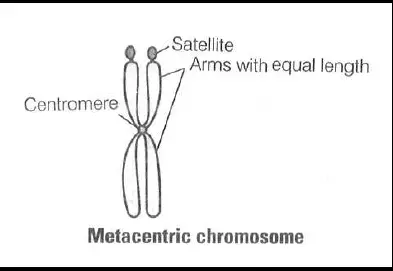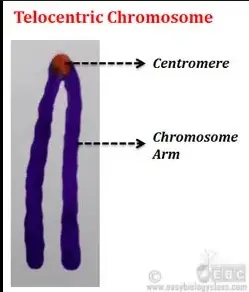Chromosomes are essential components of cellular biology, each a carefully packaged structure of DNA that plays a critical role in heredity, genetic diversity, and biological function. They come in various shapes and sizes, which can significantly influence their function and the overall genetic makeup of an organism. Centromere location within a chromosome dictates its classification into one of several types, including metacentric and telocentric, each carrying unique attributes and genetic implications.
Metacentric chromosomes have their centromere near the middle, resulting in arms of approximately equal length, while telocentric chromosomes feature a centromere at one end, making one arm almost nonexistent. These structural differences are not merely physical variations but influence genetic behavior and stability during cell division, impacting everything from gene expression to evolutionary adaptations.
Understanding the distinction between metacentric and telocentric chromosomes is crucial for geneticists and researchers. It affects how they approach studies on genetic inheritance, chromosomal disorders, and the evolutionary history of species. Such knowledge also aids in advancements in medical genetics, where the understanding of chromosome structure can lead to breakthroughs in diagnosing and treating genetic diseases.

Chromosome Basics
Structure and Function
Chromosomes are the cellular structures that house our genetic material. In the simplest terms, a chromosome is a single piece of coiled DNA containing many genes, regulatory elements, and other nucleotide sequences. Chromosomes also contain DNA-bound proteins, which help package the DNA and control its functions.
Components of a Chromosome
- Telomeres: These are repetitive nucleotide sequences at each end of a chromosome. They protect the ends of the chromosome from deterioration or from fusion with neighboring chromosomes.
- Arms: A chromosome’s arms are the elongated parts extending from the centromere. Depending on the position of the centromere, these arms can be equal or unequal in length.
- Centromere: The centromere is the part of a chromosome that links sister chromatids (or the two arms of a chromosome). During cell division, the centromere is critical as it is the point where spindle fibers attach to pull the chromatids apart.
Types of Chromosomes
Chromosomes vary greatly in shape and size across different species, and even within an organism’s own cells. Typically, they are classified based on the location of the centromere, which influences the shape of the chromosomes during cell division.
- Metacentric: The centromere is approximately in the middle, making the two arms of the chromosome about equal in length.
- Submetacentric: The centromere is slightly off center, so one arm is slightly longer than the other.
- Acrocentric: The centromere is significantly off center but not at the very end, resulting in one very short arm and one very long arm.
- Telocentric: The centromere is at the very end of the chromosome, essentially creating a single arm.
Role of Centromere Location
The position of the centromere influences the behavior of chromosomes during cell division and can affect the stability and movement of chromosomes. It also impacts genetic inheritance patterns and the likelihood of certain genetic disorders.
Metacentric Chromosomes
Definition and Features
Metacentric chromosomes, where the centromere is centrally located, result in chromosome arms of equal length. These chromosomes resemble an “X” shape during the metaphase of cell division.
Characteristics of Metacentric Chromosomes
- Symmetry: The most distinctive feature of metacentric chromosomes is their symmetrical look.
- Stability: These chromosomes tend to be more stable during cell division due to their balanced structure.
Visual Identification
In karyotyping, metacentric chromosomes can be easily identified by their balanced arm lengths and central centromere. They stand out from other types due to their uniform shape.
Role in Genetics
- Function during cell division: During mitosis and meiosis, the balanced structure of metacentric chromosomes facilitates even distribution of genetic material between daughter cells.
- Examples in various species: Humans have several metacentric chromosomes, such as chromosome 1, which is the largest and carries numerous genes.
Telocentric Chromosomes
Definition and Features
Telocentric chromosomes feature the centromere at the very end of the chromosome. This placement results in a chromosome with essentially one arm.
Characteristics of Telocentric Chromosomes
- Asymmetry: The key characteristic of telocentric chromosomes is their asymmetric structure with only one functional arm.
- Specialized function: This unique structure can play specialized roles in certain organisms, particularly during meiosis.
Visual Identification
Telocentric chromosomes appear as a simple straight line under a microscope during cell division, distinguishing them from the more common chromosome types.
Role in Genetics
- Function during cell division: Telocentric chromosomes may behave differently during cell division due to their single-armed structure, potentially impacting genetic recombination and segregation.
- Examples in various species: Telocentric chromosomes are rare in humans but are commonly found in certain rodents and plants, providing unique opportunities for genetic studies.

Comparative Analysis
Centromere Position
The location of the centromere in chromosomes plays a pivotal role in their behavior during cell division. This structural feature not only dictates the physical shape of the chromosome but also influences how chromosomes align and separate during the process of mitosis and meiosis.
- Impact on Chromosome Behavior: The centromere’s position affects the mechanical process of chromosome movement toward opposite poles during cell division. A centrally located centromere, as seen in metacentric chromosomes, allows for a more balanced and potentially less error-prone distribution. In contrast, the asymmetric division in telocentric chromosomes, where the centromere is at the end, can lead to different segregation dynamics.
Genetic Implications
The shape of chromosomes, influenced largely by the location of the centromere, affects genetic stability and activity, including gene distribution and expression.
- Gene Distribution and Expression: Chromosomes with different centromere positions expose genes to varying degrees of mechanical stress and compactness, which can affect how genes are turned on or off. For instance, genes located near the centromere in telocentric chromosomes may have different expression levels compared to those near the middle in metacentric chromosomes.
Evolutionary Perspective
The evolution of chromosome shapes across different species suggests a complex interaction between genetic function and environmental adaptation.
- Evolution of Chromosome Shapes: The diversity in chromosome structures, from metacentric to telocentric, likely reflects various evolutionary pressures. These structures might have developed as adaptations to cellular and reproductive needs, affecting the fitness and survival of species.
Practical Applications
Genetic Research
Understanding chromosome structures has vast implications in genetics, from basic research to advanced genetic engineering.
- Use in Genetic Engineering and Research: Scientists leverage knowledge of chromosome architecture to manipulate genetic material for disease resistance, crop improvement, and therapeutic genetic modifications.
Medical Implications
Chromosome structure plays a crucial role in medical science, particularly in understanding and treating genetic disorders.
- Impact on Human Health and Disease: Abnormalities in chromosome structure can lead to diseases such as cancer, Down syndrome, and other genetic disorders. Understanding how chromosome shape affects cellular processes is key in developing diagnostic and therapeutic strategies.
Challenges and Considerations
Research Limitations
Studying chromosomes presents unique challenges due to their complex nature and the intricate techniques required to observe them at the molecular level.
- Challenges in Studying Chromosomal Differences: The microscopic size of chromosomes and the dynamic nature of their behavior during cell division make it difficult to capture precise biological processes.
Future Prospects
Advances in biotechnology and genetics hold promising potential for the future of chromosomal research.
- Emerging Technologies and Their Potential Impact: Technologies such as CRISPR-Cas9 and advanced microscopy are revolutionizing our ability to study and manipulate chromosomes. These tools are enhancing our understanding of genetic diseases and opening new avenues for treatments.
Frequently Asked Questions
What Are Chromosomes?
Chromosomes are long, string-like structures made of DNA and proteins found in the nucleus of most living cells. They are responsible for carrying genetic information that dictates individual traits from physical appearance to susceptibility to certain diseases.
Why Are Chromosomes Important?
Chromosomes are vital because they contain the entire genome of an organism. They ensure DNA is accurately copied and distributed in the process of cell division, which is crucial for growth, reproduction, and maintaining healthy bodily functions.
How Do Metacentric and Telocentric Chromosomes Differ?
Metacentric chromosomes have a centrally placed centromere that creates arms of equal length, making them appear roughly symmetrical. In contrast, telocentric chromosomes possess a terminal centromere with one very short or absent arm, resulting in an asymmetrical appearance.
What Role Do Chromosome Structures Play in Genetics?
The structure of a chromosome affects its behavior during cell division and can influence genetic outcomes. Variations in chromosome structure, like those seen in metacentric and telocentric chromosomes, play critical roles in genetic diversity and evolutionary processes.
Can Chromosome Abnormalities Affect Health?
Yes, abnormalities in chromosome structure or number can lead to various health issues, including genetic disorders like Down syndrome, Turner syndrome, and Klinefelter syndrome. Such conditions often result from nondisjunction or structural defects during cell division.
Conclusion
Chromosomes serve as the backbone of genetic understanding and medical genetics. By studying the structural variations between metacentric and telocentric chromosomes, scientists can gain insights into the complexities of gene distribution and expression, which are fundamental in addressing chromosomal disorders. Such knowledge paves the way for innovative treatments and a deeper understanding of human genetics.
In sum, the intricate details of chromosome structures significantly enrich our comprehension of biology. As research advances, the distinctions between different types of chromosomes continue to highlight the remarkable adaptability and complexity of life at a molecular level, offering promising avenues for future scientific and medical breakthroughs.

